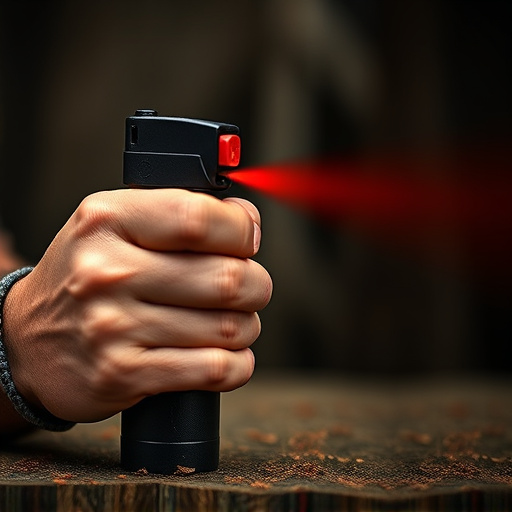Tactical pepper spray, like bear spray, uses capsicum chemicals to deter bears up to 30 feet away by causing temporary blindness and respiratory distress. Effective deployment involves aiming at the face into the wind from a close range (20-30 feet), creating a thick cloud covering sensitive areas. Regular practice is crucial for stress application. Safety precautions include keeping spray accessible, learning proper targeting techniques, washing exposed areas with soap and water upon exposure, seeking medical attention if irritation persists, removing contaminated clothing, and reporting the incident to local authorities. Combining bear spray with noise-making devices and knowledge of bear behavior provides the best defense in "bear country."
“In areas frequented by bears, knowing how to defend yourself is crucial. This guide explores bear spray as a vital tool in animal attack prevention, offering both protection and a strategic retreat. We delve into the science behind ‘tactical pepper spray deployment methods’, examining its composition and effectiveness against aggressive bears.
Learn essential tactics to maximize safety during encounters, along with critical post-exposure steps, ensuring you’re prepared for potential bear interactions.”
- Understanding Bear Spray: Composition and Effectiveness
- Tactical Deployment Techniques for Optimal Protection
- Safety Precautions and Post-Exposure Steps
Understanding Bear Spray: Composition and Effectiveness
Bear spray, also known as tactical pepper spray, is a crucial tool in the arsenal of anyone venturing into bear country. It’s designed for deployment when faced with an aggressive bear attack, using capsicum-based chemicals to disable and deter the animal. The composition typically includes capsaicin, the active ingredient found in chili peppers, mixed with water and other additives to create a mist that can reach distances up to 30 feet. This non-lethal method offers a tactical advantage by providing time for escape or a chance to retreat to safety without causing permanent harm.
The effectiveness of bear spray lies in its ability to cause temporary blindness, coughing, and pain in the eyes and respiratory system of the bear. Proper deployment methods, such as aiming for the face and blowing the spray into the wind, can significantly reduce the risk of an attack. However, it’s essential to remember that bear spray is not a guarantee of safety; factors like distance, weather conditions, and individual bear behavior can affect its performance. Therefore, combining tactical pepper spray deployment methods with awareness, noise-making devices, and knowledge about bear behavior offers the best line of defense.
Tactical Deployment Techniques for Optimal Protection
When it comes to tactical deployment, knowing how and when to use bear spray is paramount for optimal protection in potential animal encounters. For effective defense against bears or other wildlife, individuals should aim to apply the spray at close range, typically within 20-30 feet (6-9 meters). The goal is to create a protective barrier around oneself by covering the face and eyes, which are sensitive areas for animals, with a thick cloud of pepper spray. This tactic disrupts the animal’s behavior, allowing for an escape or de-escalation of the situation.
Tactical pepper spray deployment methods include using quick, short bursts to startle and disorient the target while maintaining a safe distance. It’s crucial to practice these techniques regularly to ensure swift and accurate application under stress. Individuals should also be aware of their surroundings, including potential escape routes and safe havens nearby, as part of their overall survival strategy during encounters with aggressive wildlife.
Safety Precautions and Post-Exposure Steps
When carrying bear spray as a defense mechanism, it’s crucial to understand safety precautions and post-exposure steps for optimal protection. Always keep the spray in an easily accessible, clearly marked container, following manufacturer guidelines for storage. Familiarize yourself with tactical pepper spray deployment methods, such as aiming for facial and respiratory targets, ensuring you maintain a safe distance while effectively deterring potential attackers.
In the event of exposure to animal attacks or spray use, prompt actions are vital. Wash affected areas thoroughly with soap and water, seeking medical attention immediately if irritation persists or breathing becomes difficult. Remove contaminated clothing and shoes, and report the incident to local authorities who can provide further guidance based on regional protocols and expertise.
Bear spray, a potent defense against animal attacks, requires strategic deployment for maximum effectiveness. By understanding its composition and tactical application, individuals can ensure their safety in bear country. Adhering to safety precautions before and after exposure is crucial, making bear spray a valuable tool when navigating potential encounters. Utilizing proper deployment methods, such as the pulse technique, and staying informed about post-exposure steps, can significantly enhance survival chances during unexpected interactions with bears. Remember, knowledge of tactical pepper spray deployment methods is key to protecting yourself in these wild environments.
